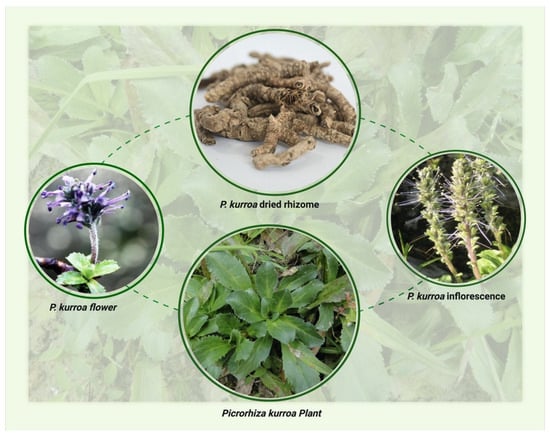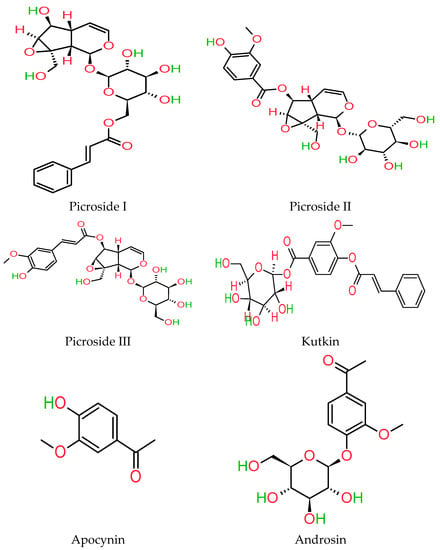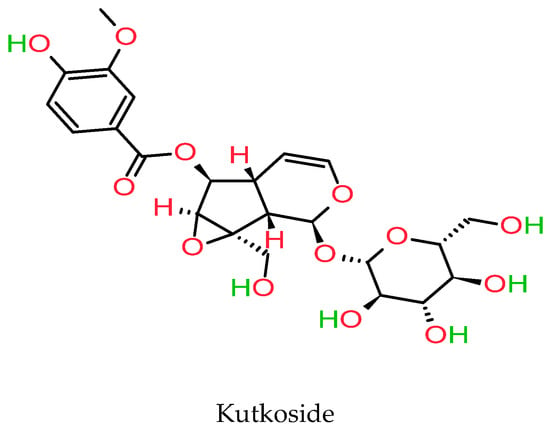You're using an outdated browser. Please upgrade to a modern browser for the best experience.
Please note this is a comparison between Version 1 by Shadma Wahab and Version 2 by Conner Chen.
Traditional remedies for the treatment of various ailments are gaining popularity. Traditionally, one of the most valuable therapeutic herbs has been Picrorhiza kurroa (P. kurroa) Royle ex Benth. Traditional and folk uses of P. kurroa include chronic constipation, skin-related problems, burning sensation, chronic reoccurring fever, jaundice, heart problems, breathing, digestion, allergy, tuberculosis, blood-related problems, prediabetes and obesity, laxative, cholagogue, and liver stimulatory.
- Picrorhiza kurroa
- medicinal plants
- natural product
- phytochemical
1. Introduction
The steadily growing life expectancy, contemporary lifestyles, and changing environmental circumstances are responsible for the rising prevalence of the processes leading to various illnesses. The death rate due to multiple ailments has increased worldwide. Over the years, it has become necessary to seek new treatments that may cure chronic diseases and other infectious disorders [1][2][1,2].
Picrorhiza is derived from the Greek language, which means “bitter” (picros) and “roots” (rhiza). Picrorhiza is a genus comprising two species (Picrorhiza scrophulariiflora Pennell and Picrorhiza kurroa (P. kurroa) Royle ex Benth) of the family Plantaginaceae. Most species are found in nature at sites such as cliffs, crevices, and mountainsides. Picrorhiza kurroa Royle ex Benth is mainly found at an altitude of 3000–5000 m above sea level in the Himalayan ranges of Nepal, Pakistan, and India [3][4][4,5]. This plant grows on rocky slopes and organic and moist soils in the Himalayan region (Garhwal to Bhutan). It is also found in northern Burma, western China, and southeastern Tibet [4][5]. It is also grown in the central and eastern regions but is abundant in the northwestern region [3][4]. It is a well-established herbal medicine for many ailments, ranging from dyspepsia to hepatitis [5][6]. Traditional and modern medicine have used bitter extracts from the dried rhizomes of this plant as a purgative, brain tonic, stomachic, and antiperiodic to treat dyspepsia [6][7][8][7,8,9]. Many traditional herbs are known for their cooling, heating, or neutral properties. If the heat is reduced by a herb, it becomes known for its cooling properties. P. kurroa has a cooling effect and is used as an antipyretic, cardiotonic, laxative, antiasthmatic, and anthelmintic [9][10]. Bhandari et al. (2010), Rana et al. (2018), and Bhattacharjee (2013) provided local names and botanical descriptions of P. kurroa [10][11][12][11,12,13]. P. kurroa has been used to treat respiratory diseases, allergies, inflammatory conditions, fever, diarrhea, chronic scorpion stings, asthma, and liver-related diseases [10][13][14][15][11,14,15,16]. Hepatoprotective effects against carbon tetrachloride, alcohol, isoniazid, paracetamol, amanita mushrooms, rifampicin, Plasmodium berghei, and aflatoxin B1 poisoning have been reported [16][17][18][19][20][21][22][17,18,19,20,21,22,23]. Jaundice can be treated with P. kurroa [23][24]. The ethanolic extract contains 50–60 percent of two iridoid glycohepatosides in the ratio of 1:1.5, picroside-I, and kutkoside, which have been proven to have powerful hepatoprotective effects against miscellaneous hepatotoxins, including alcohol in preclinical studies. The active constituents of kutki consist of kutkoside and iridoid glycosides (IGs) (picroside I and II), which are primarily found in the rhizome and roots [24][25].
No major adverse effects have been reported for this plant. The diverse pharmacological activities of P. kurroa, a medicinally significant endangered plant, have led researchers to develop practical techniques for its in vitro mass multiplication [6][7][8][7,8,9]. The International Union for Conservation of Nature (IUCN) reported that this species should be protected under the rare endangered species (RET) category. Practical actions, such as in situ and ex situ conservation, are required to preserve this plant [25][26][26,27].
 Traditional medicine is affordable and widely available in developing nations, and many people rely on it for their primary healthcare needs. In Ayurveda, P. kurroa is known as “kutki” or “Katuka” and has several health advantages recorded in both Samhitas (medical treatise of Ayurveda) [27][28]. Nighantu (an important treatise on ayurvedic herbs that mentions names of drugs from various sources, such as vegetables, minerals, and animals, and their synonyms, actions, and uses) examined and discussed the qualities and dosages of P. kurroa for treating various illnesses [28][29]. Adarsa Nighantu also explains how to properly use the herb’s root portion as the recommended daily dose [29][30]. Tibetan medical experts and non-specialists use this plant’s rhizomes to cure colds, coughs, skin diseases, liver diseases, fever, indigestion, jaundice, scorpion stings, hepatitis, and metabolic problems [30][31][31,32]. A brief botanical description of P. kurroa is shown in Table 1.
Traditional medicine is affordable and widely available in developing nations, and many people rely on it for their primary healthcare needs. In Ayurveda, P. kurroa is known as “kutki” or “Katuka” and has several health advantages recorded in both Samhitas (medical treatise of Ayurveda) [27][28]. Nighantu (an important treatise on ayurvedic herbs that mentions names of drugs from various sources, such as vegetables, minerals, and animals, and their synonyms, actions, and uses) examined and discussed the qualities and dosages of P. kurroa for treating various illnesses [28][29]. Adarsa Nighantu also explains how to properly use the herb’s root portion as the recommended daily dose [29][30]. Tibetan medical experts and non-specialists use this plant’s rhizomes to cure colds, coughs, skin diseases, liver diseases, fever, indigestion, jaundice, scorpion stings, hepatitis, and metabolic problems [30][31][31,32]. A brief botanical description of P. kurroa is shown in Table 1.
2. Ethnobotanical Properties of P. kurroa
Picrorhiza kurroa plants have a long creeping rootstock that is bitter and grows in rock crevices and moist, sandy soil. The plant’s leaves are oval, flat, and serrated. The flowers are pale purple or white, appear from June to August, and are borne on a tall spike. The plants are harvested manually from October to December. The morphological features of the plant are depicted in Figure 1.
Figure 1.
The morphological features of
Picrorhiza kurroa
.
Table 1.
A brief botanical description of
Picrorhiza kurroa
.
| Kingdom | Plantae |
| Subkingdom | Tracheobionta |
| Super-division | Spermatophyta |
| Division | Magnoliophyta |
| Class | Mannoliopsida |
| Subclass | Asteridae |
| Order | Lamiales |
| Old Family | Scrophulariaceae |
| New Family | Plantaginaceae |
| Genus | Picrorhiza |
| Species | P. kurroa |
3. Phytochemistry
Picrorhiza has been widely explored in terms of its chemistry, and several physiologically active compounds have been extracted from its rhizomes, roots, seeds, stems, and leaves [32][33][34][35][36][33,34,35,36,37]. This plant yielded more than 65 secondary metabolites. P. kurroa rhizomes and roots produce a crystalline substance called “Picroliv” or “Kutkin,” a combination of two C9-IGs known as kutkoside. Picroside-II and picroside-I were found in a ratio of 2:1 [37][38]. Picrosides I, II, and III, cucurbitacins, and kutkoside are IGs identified in the rhizomes of P. kurroa and determined using HPLC (high-performance liquid chromatography) techniques [38][39]. P. kurroa has various bioactive chemicals with pharmacological and therapeutic potential, including glycosides, iridoids, alkaloids, phenolics, terpenes, and cucurbitacins [39][40][41][42][43][40,41,42,43,44]. In addition to its purgative and emaciating properties, picrorhiza also has abortifacient and digestive properties, cholagogue, appetizing properties, and heart and liver-stimulating actions [44][45]. The active constituent of P. kurroa, known as kutkin, is a mixture of kutkoside and picroside. Kutkin (picrosides and kutkosides) has shown hepatoprotective properties pharmacologically. Drosin and apocyanin are two other bioactive chemicals isolated from this plant. Apocynin is a catechol that may counteract the oxidative response of neutrophils [45][46]. Steroidal glycosides such as cucurbitacins B, R, and D have been isolated from chloroform/ethyl acetate and methanol extracts of the roots of P. kurroa [29][35][46][47][48][30,36,47,48,49]. Cucurbitacins B, D, and R, found in P. kurroa, are well-known for their anti-tumorous and cytotoxic properties. Apocynin is a potent NADPH (nicotinamide adenine dinucleotide phosphate) oxidase inhibitor and has anti-inflammatory and antioxidant properties. Androsin has an antiasthmatic effect [49][50]. LC–ESI–MS/MS (liquid chromatography–electrospray ionization/multi-stage mass spectrometry) techniques have also reported the presence of picrosides (I, II, III, and IV), kutokoside, pikurosides, and flavonoids such as vanillic acid and apocynin in the 70 percent hydroalcoholic fraction [33][34]. P. kurroa also contains other important compounds, e.g., carbohydrate D-mannitol and aromatic acids such as vanillic acid, cinnamic acid, and ferulic acid [50][51][51,52]. Figure 2 shows various secondary metabolites of P. kurroa.




Figure 2.
Major phytoconstituents extracted from
P. kurroa
.
Some studies have performed a physicochemical examination of P. kurroa. The total ash (5.92% w/w), pH of 10% aqueous solution (12.95), moisture content (12.95% v/w), insoluble acid ash (2.14% w/w), water-soluble ash (3.35% w/w) were reported [52][53][54][53,54,55]. Vanillic acid, the main phenolic component, was calculated to be present in P. kurroa roots at a rate of 161.2 mg/100 g dry weight [55][56]. A separate investigation compared the total phenolic content of methanolic and aqueous extracts at various concentrations (50, 100, 150, and 200 g). The methanolic extract (14.11–35.36 g GAE) showed a more considerable amount of total phenolics than the aqueous extract (10.79–24.87 g GAE) [56][57]. Based on HPLC analysis, the total phenolic content of roots was determined to be 3.14 mg/100 g of dry weight [57][58]. In a related investigation, 222 μg GAE/mg and 197 μg QE/mg of dry root were determined to be the total phenolics and flavonoids in a 70% ethanol extract [33][34]. The hydro methanolic extract of P. kurroa was calculated to contain 544 mg GAE/g and 400 mg RE of total phenolics and flavonoids, respectively [58][59].
